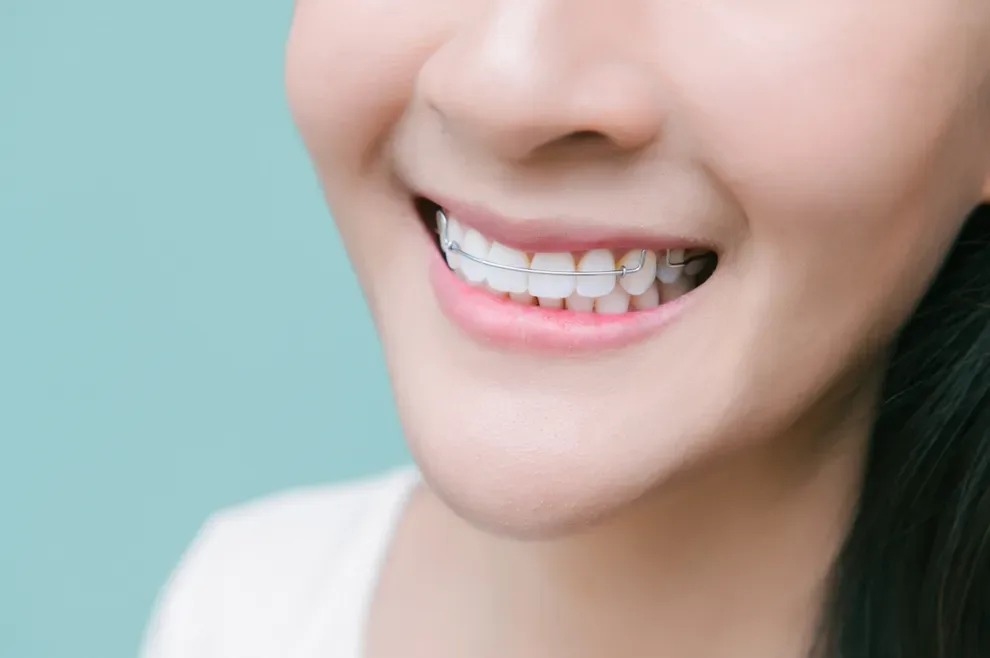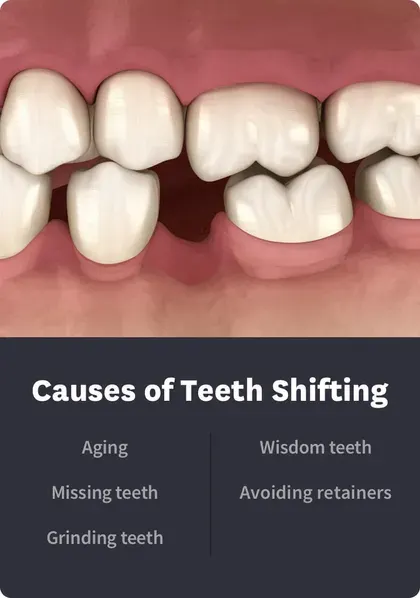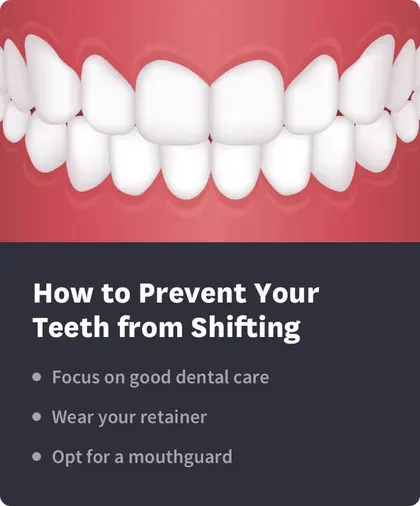Teeth Shifting? Here's What to Do (& Not to Do).

Table of Contents
- Causes of Shifting Teeth
- Prevention
- Harmful Techniques
- When to See an Expert
- Fixing Shifted Teeth
It's not unusual for your teeth to shift. Everything from aging to dental disease can prompt your teeth to take up new positions.
Your first task is to avoid panic. Next, take action. Unless you address the cause of your teeth movement, they'll keep on shifting until your smile is barely recognizable.
Sometimes, you need a doctor's help to stop the shift. But sometimes, at-home care can do the trick.
What Does Teeth Shifting Look & Feel Like?
You may notice teeth shifting when you look in the mirror. If you’re in the habit of examining your smile regularly, even tiny changes in the way your teeth fit together could be noticeable.
Other signs of teeth shifting include the following:
Trapped food: Do you obsessively check your teeth for debris after eating? Gaps in your teeth can allow seeds, garnishes, and herbs to collect inside your mouth.
Bad breath: When debris stays in your mouth, it can lead to unpleasant odors.
Difficulty flossing and brushing: Teeth can bunch up and crowd together as they move, making routine cleaning difficult.
Changes in your bite: You may notice that your teeth tap together in unusual ways, or it might be harder to manipulate food like hot dogs or sandwiches.
Speech alterations: Moving teeth can result in a new lisp or other vocal change.
Causes of Shifting Teeth
Before you can know how to help your teeth stick to one spot, you'll need to understand why they are moving. Your teeth could be shifting for a variety of reasons.

Aging
The American Association of Orthodontists says the jaw bone loses density and shrinks with age. This age-related issue causes the jaw bone to become mismatched, allowing teeth to collapse against one another. Crowding of the bottom front teeth can develop. If you have habits like breathing through your mouth or thrusting your tongue, it can worsen.
Women may be more susceptible to this issue than men. Experts say women going through menopause have less estrogen, which can lead to bone breaking down quicker than it builds up. The jawbone is particularly prone to this problem.
Missing Teeth
Injury or illness could prompt the removal of one or several of your teeth. Typically, dentists recommend bridges or caps to fill the gaps. Without them, experts say, your teeth slowly drift to fill the leftover space.
The teeth closest to the gap shift first, but then their neighbors follow suit. In time, experts say, your entire smile could be filled with gaps.
Wisdom Teeth
The back corners of your mouth host your wisdom teeth, and these molars often develop when your smile is relatively set. They can fail to break through the gums at all. They can also develop horizontally, and when that happens, they push on neighboring teeth. Some people feel pain when these teeth do this, but others feel nothing at all.
Avoiding Retainers
After you wear braces or aligners, you must wear retainers to protect your investment and keep your teeth in place. Typically, you wear a retainer for 12 hours per day for the first six months. Then, you wear it at night indefinitely.
Skip one or both of those steps, and your teeth could attempt to move back to their prior positions.
Dental Procedures
Because of the space caused by the missing tooth, teeth shifting can happen quickly after procedures like a tooth extraction or wisdom tooth removal. Replacing a missing tooth with implants, a bridge, or dentures can ensure that your bite is held in place.
It’s also important for your oral health. Not treating a lost tooth can result in increased risk of decay and gum disease. It can also impact your daily life by making eating and speaking more difficult.
Other dental procedures can cause shifting too, especially if done incorrectly. An ill-fitting dental crown, for example, can cause bad bite patterns and lead to alignment issues.
Grinding Teeth
Your muscles should relax at night while you sleep. But for some people, the nighttime is punctuated by periodic clenching and unclenching of the jaw muscles. This is bruxism, and it can cause your teeth to move.
Pressure is unevenly placed within your jaw, and some teeth take the brunt of your muscle movement. Those teeth begin to rotate or shift, and their neighbors start to do the same. Bruxism is common in children, experts say, but it's less common in adults.Some people have a combination of issues sparking tooth movement. You may forget your retainers and then notice that your wisdom teeth are appearing, for example. But most people have an issue doctors consider the prime cause of tooth movement. Fixing that issue is vital.
“If your teeth move due to grinding or avoiding retainers, the solution is clear, but if it's caused by something like wisdom teeth or missing teeth, you may need more help from a professional.”
How to Stop and Prevent your Teeth from Shifting
When you know that your teeth are shifting, and you've pinpointed what seems to be the primary cause, you can take action.
Teeth in poor alignment are more prone to decay, which can lead to cavities and (potentially) tooth loss. If your jaws aren’t in alignment, you can develop significant pain or even popping and clicking when you open and close your mouth. A shifting smile can also be unsightly, and if it impacts your speech, it can be hard to ignore.
To halt future tooth shifts:

Emphasize Good Dental Care
Your teeth are rooted firmly to your jaw via ligaments and bones. But your gums work to support your teeth as they root down into lower structures.
Poor dental hygiene can result in bacteria accumulating in pockets between your teeth and gums. This can also allow your teeth to flex. Keeping your teeth clean can keep this from happening.
Wear your Retainer
If you've worn braces or aligners, your retainer isn't optional. This tool doesn't exert the same force used by clear aligners and braces, experts say, but it can apply gentle pressure that keeps your teeth from straying too far. Follow instructions and wear this device properly.
Opt for a Mouthguard
If you grind your teeth at night, a soft split can keep your teeth from touching. Your muscles may still clench and grind, but the surfaces won't connect. That could keep your teeth from moving.
Guards like this can be made of hard acrylic or softer materials.
Techniques That Can Be Harmful
Many of the solutions we've mentioned above have an at-home component. You can head to the drugstore and buy a mouth guard, for example. And you don't need a prescription for toothpaste or floss. But some at-home techniques you might be tempted to try can harm your teeth.
Don't use tools like rubber bands or string to tie your teeth together and stop them from moving. These items can creep up your teeth and lodge firmly in the roots. Once there, they can kill your teeth altogether.
Similarly, don't chew on sticks or ice. Some people believe that nibbling on something hard like this can freeze your teeth in place, so they won’t shift at all. There’s no evidence that this works.
When to See an Expert
Sometimes, you can stop your teeth from moving with at-home tools and a bit of persistence. But sometimes, an expert must help you to protect and amend your smile.
You'll need to visit a dentist or orthodontist if your teeth are moving due to:
Missing teeth. You'll need a bridge to fill the gap and ensure that neighboring molars don’t drift. You can't make a tool like this at home, so you'll need to visit an expert for help.
Underlying disease. If your gums bleed, swell, turn red, or pull away from your teeth, you could have an oral health issue. An in-depth cleaning below the gumline could help your doctor to clear out bacteria you can't touch with a brush. That could put you on a course to a healthier mouth.
New teeth. Impacted or misaligned wisdom teeth are often pulled to preserve the health of the rest of the mouth. This isn't something you can do at home.
Injury. A blow to the face can make your teeth wobble and weave. It's often temporary, but a visit to a dental expert can ensure that the small issue you have now doesn't develop into something bigger.
How to Fix Teeth That Have Shifted
No matter what caused your teeth to migrate, it’s important to address any orthodontic problems that have been caused by teeth shifting.
A misaligned bite due to shifted teeth can cause jaw problems — including TMJ (temporomandibular joint) problems — as well as problems eating and speaking. This misalignment can cause other problems as well, including headaches and back and shoulder pain.
The new positioning of migrated teeth can also lead to oral health issues, as crowding or spaces can allow for pockets of plaque and particle buildup to form, creating a higher risk of decay and gum disease.
Possible treatment for orthodontic problems caused by shifted teeth include the following:
A retainer: Retainers are meant to hold your teeth in place after treatment, not straighten them after they’ve shifted. However, in cases of very slight shifting soon after treatment, your orthodontist may suggest wearing a retainer for correction.
How long you’ll wear the retainer for (and for how many hours a day) will depend on your treatment needs. Most retainers are removable and made of plastic or metal. Permanent retainers are applied to the back of teeth for correction and can only be removed by an orthodontist.
Braces: Your orthodontist may recommend braces for teeth that have shifted enough to create a bite or alignment issue. While traditional metal braces are still available and the most affordable option, you can also opt for less visible ceramic braces. The most expensive option is lingual braces, which are applied to the back of the teeth.
Clear aligners: For most mild and moderate orthodontic issues caused by shifting teeth, clear at-home aligners may be an ideal option. They’re more affordable than braces, with faster treatment times. Aligners are also removable and convenient. Some top aligner providers offer a completely at-home process that requires no in-office visits.
